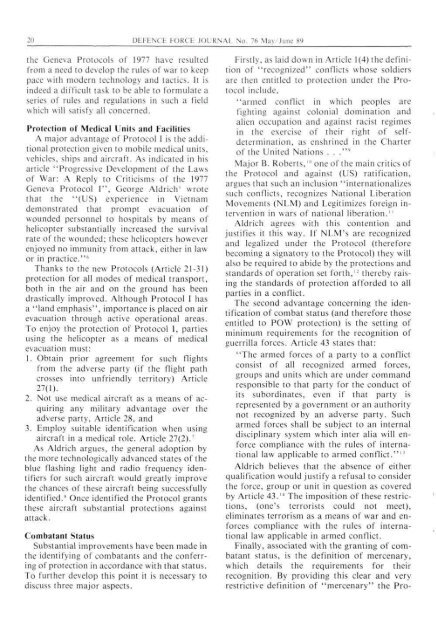ISSUE 76 : May/Jun - 1989 - Australian Defence Force Journal
ISSUE 76 : May/Jun - 1989 - Australian Defence Force Journal
ISSUE 76 : May/Jun - 1989 - Australian Defence Force Journal
- No tags were found...
You also want an ePaper? Increase the reach of your titles
YUMPU automatically turns print PDFs into web optimized ePapers that Google loves.
20 DEFENCE FORCE JOURNAL No. <strong>76</strong> <strong>May</strong>/<strong>Jun</strong>e 89the Geneva Protocols of 1977 have resultedfrom a need to develop the rules of war to keeppace with modern technology and tactics. It isindeed a difficult task to be able to formulate aseries of rules and regulations in such a fieldwhich will satisfy all concerned.Protection of Medical I nits and FacilitiesA major advantage of Protocol I is the additionalprotection given to mobile medical units,vehicles, ships and aircraft. As indicated in hisarticle "Progressive Development of the Lawsof War: A Reply to Criticisms of the 1977Geneva Protocol I", George AldricrT wrotethat the "(US) experience in Vietnamdemonstrated that prompt evacuation ofwounded personnel to hospitals by means ofhelicopter substantially increased the survivalrate of the wounded; these helicopters howeverenjoyed no immunity from attack, either in lawor in practice." 6Thanks to the new Protocols (Article 21-31)protection for all modes of medical transport,both in the air and on the ground has beendrastically improved. Although Protocol I hasa "land emphasis", importance is placed on airevacuation through active operational areas.To enjoy the protection of Protocol I, partiesusing the helicopter as a means of medicalevacuation must:1. Obtain prior agreement for such flightsfrom the adverse party (if the flight pathcrosses into unfriendly territory) Article27(1).2. Not use medical aircraft as a means of acquiringany military advantage over theadverse party, Article 28, and3. Employ suitable identification when usingaircraft in a medical role. Article 27(2). 7As Aldrich argues, the general adoption bythe more technologically advanced states of theblue flashing light and radio frequency identifiersfor such aircraft would greatly improvethe chances of these aircraft being successfullyidentified." Once identified the Protocol grantsthese aircraft substantial protections againstattack.Combatant StatusSubstantial improvements have been made inthe identifying of combatants and the conferringof protection in accordance with that status.To further develop this point it is necessary todiscuss three major aspects.Firstly, as laid down in Article 1(4) the definitionof "recognized" conflicts whose soldiersare then entitled to protection under the Protocolinclude,"armed conflict in which peoples arefighting against colonial domination andalien occupation and against racist regimesin the exercise of their right of selfdetermination,as enshrined in the Charterof the United Nations . . ." 9Major B. Roberts, 10 one of the main critics ofthe Protocol and against (US) ratification,argues that such an inclusion "internationalizessuch conflicts, recognizes National LiberationMovements (NLM) and Legitimizes foreign interventionin wars of national liberation."Aldrich agrees with this contention andjustifies it this way. If NLM's are recognizedand legalized under the Protocol (thereforebecoming a signatory to the Protocol) they willalso be required to abide by the protections andstandards of operation set forth, 12 thereby raisingthe standards of protection afforded to allparties in a conflict.The second advantage concerning the identificationof combat status (and therefore thoseentitled to POW protection) is the setting ofminimum requirements for the recognition ofguerrilla forces. Article 43 states that:"The armed forces of a party to a conflictconsist of all recognized armed forces,groups and units which are under commandresponsible to that party for the conduct ofits subordinates, even if that party isrepresented by a government or an authoritynot recognized by an adverse party. Sucharmed forces shall be subject to an internaldisciplinary system which inter alia will enforcecompliance with the rules of internationallaw applicable to armed conflict.""Aldrich believes that the absence of eitherqualification would justify a refusal to considerthe force, group or unit in question as coveredby Article 43.'" The imposition of these restrictions,(one's terrorists could not meet),eliminates terrorism as a means of war and enforcescompliance with the rules of internationallaw applicable in armed conflict.Finally, associated with the granting of combatantstatus, is the definition of mercenary,which details the requirements for theirrecognition. By providing this clear and veryrestrictive definition of "mercenary" the Pro-
















